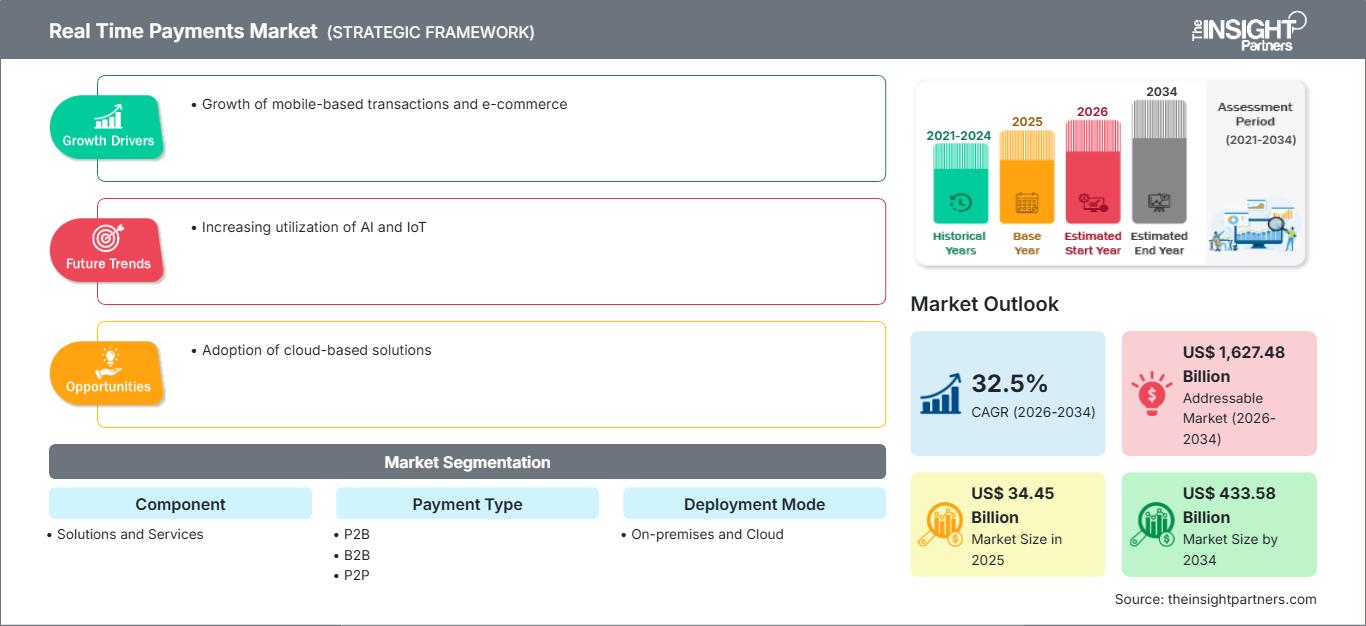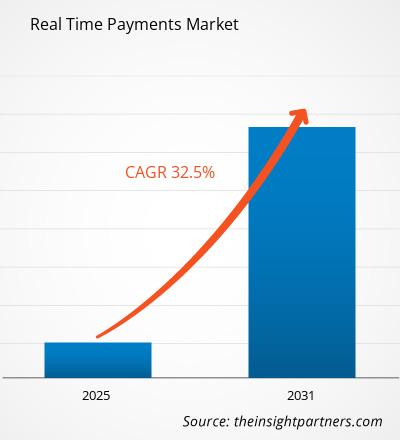Si prevede che il mercato dei pagamenti in tempo reale, valutato a 34,45 miliardi di dollari nel 2025, raggiungerà i 433,58 miliardi di dollari entro il 2034, con un CAGR del 32,5% nel periodo 2026-2034. Le condizioni di mercato continuano a evolversi, aprendo nuove opportunità per gli stakeholder. Il panorama generale riflette un progresso stabile e un potenziale di crescita a lungo termine.
Analisi del mercato dei pagamenti in tempo reale
La crescita del mercato può essere attribuita all'uso diffuso degli smartphone e all'adozione di soluzioni basate su cloud per un'elaborazione più rapida dei pagamenti. La crescente disponibilità e utilizzo degli smartphone ha portato a una maggiore domanda di prodotti e servizi pensati per gli utenti mobili.
Panoramica del mercato dei pagamenti in tempo reale
Real Time Payments (RTP) è un sistema finanziario all'avanguardia che consente alle aziende di effettuare transazioni istantanee e senza interruzioni. A differenza dei metodi di pagamento tradizionali, che spesso comportano ritardi e processi manuali, RTP consente il trasferimento immediato dei fondi, garantendo un'elaborazione dei pagamenti rapida ed efficiente. Con RTP, le aziende possono godere dei vantaggi di pagamenti immediati, eliminando la necessità di tempi di attesa e riducendo il rischio di ritardi nei pagamenti. Questa funzionalità in tempo reale consente alle organizzazioni di ottimizzare il flusso di cassa, migliorare la gestione della liquidità e migliorare le prestazioni finanziarie complessive. Inoltre, RTP offre misure di sicurezza avanzate per proteggere le aziende e i loro clienti da attività fraudolente. Il sistema utilizza tecniche di crittografia e protocolli di autenticazione avanzati, garantendo che ogni transazione venga eseguita in modo sicuro e riservato.
Riceverai la personalizzazione gratuita di qualsiasi report, incluse parti di questo report, analisi a livello nazionale, pacchetto dati Excel e potrai usufruire di fantastiche offerte e sconti per start-up e università.
Mercato dei pagamenti in tempo reale: approfondimenti strategici

-
Scopri le principali tendenze di mercato di questo rapporto.Questo campione GRATUITO includerà analisi dei dati, che spaziano dalle tendenze di mercato alle stime e alle previsioni.
Driver e opportunità del mercato dei pagamenti in tempo reale
Crescita delle transazioni basate su dispositivi mobili e dell'e-commerce per favorire la crescita del mercato dei pagamenti in tempo reale
La continua crescita dello shopping online e delle vendite tramite e-commerce ha rappresentato un fattore determinante per lo sviluppo del mercato dei pagamenti in tempo reale. La crescente popolarità del commercio mobile e la praticità che offre stanno contribuendo alla crescita del mercato. La praticità dello shopping tramite dispositivi mobili è un fattore determinante per la crescita del commercio mobile. Tre consumatori su quattro affermano di effettuare acquisti tramite dispositivi mobili perché consentono di risparmiare tempo. Tuttavia, c'è ancora margine di miglioramento, poiché il 90% degli acquirenti ritiene che la propria esperienza con il commercio mobile potrebbe essere migliore. La quota di vendite tramite e-commerce mobile sul totale delle vendite tramite e-commerce è in aumento. Si prevede che raggiungerà una quota di mercato del 60% nel 2024, il che significa che 3 dollari su 5 spesi in acquisti online saranno effettuati tramite un dispositivo mobile.
Adozione di soluzioni basate sul cloud
L'adozione di soluzioni basate su cloud sta trainando il mercato dei pagamenti in tempo reale grazie a diversi vantaggi chiave. Le soluzioni basate su cloud offrono scalabilità, flessibilità e convenienza, rendendole opzioni interessanti per aziende e istituti finanziari. Inoltre, le soluzioni basate su cloud offrono convenienza, offrendo un'alternativa più conveniente e scalabile alle tradizionali soluzioni on-premise. Gli istituti finanziari possono risparmiare sui costi sfruttando la scalabilità e la flessibilità delle soluzioni basate su cloud, consentendo loro di adattarsi alle nuove tendenze del mercato e alle esigenze dei clienti in modo più efficiente. Le soluzioni basate su cloud consentono inoltre agli istituti finanziari di innovare e adattarsi alle mutevoli esigenze. Sfruttando il cloud computing, le banche possono offrire più facilmente nuovi servizi e adattarsi alle mutevoli condizioni di mercato. Questa flessibilità e scalabilità rendono le soluzioni basate su cloud utili per promuovere l'innovazione nei sistemi di pagamento.
Analisi della segmentazione del rapporto di mercato sui pagamenti in tempo reale
Segmenti chiave che hanno contribuito alla derivazione del componente di analisi del mercato dei pagamenti in tempo reale, tipo di pagamento, modalità di distribuzione e utente finale.
- In base ai componenti, il mercato si divide in soluzioni e servizi. Il segmento delle soluzioni deteneva una quota di mercato maggiore nel 2023.
- In base alla tipologia di pagamento, il mercato è suddiviso in P2B, B2B, P2P e altri. Il segmento P2B deteneva una quota di mercato maggiore nel 2023.
- In base alla modalità di distribuzione, il mercato si divide in on-premise e cloud. Il segmento on-premise ha detenuto una quota di mercato maggiore nel 2023.
- In base all'utente finale, il mercato è suddiviso in vendita al dettaglio e commercio elettronico, BFSI, IT e telecomunicazioni, viaggi e turismo, pubblica amministrazione, sanità, energia e servizi di pubblica utilità. Il segmento vendita al dettaglio e commercio elettronico ha detenuto una quota di mercato maggiore nel 2023.
Analisi della quota di mercato dei pagamenti in tempo reale per area geografica
L'ambito geografico del rapporto sul mercato dei pagamenti in tempo reale è suddiviso principalmente in cinque regioni: Nord America, Asia Pacifico, Europa, Medio Oriente e Africa e Sud America/America Meridionale e Centrale. L'Asia Pacifico ha dominato il mercato dei pagamenti in tempo reale nel 2023. Si prevede che il mercato regionale registrerà una rapida crescita nel periodo di previsione, con il più alto tasso di crescita annuo composto (CAGR). Si prevede che la crescente adozione di soluzioni di pagamento in tempo reale da parte di imprese sia di grandi dimensioni che di piccole e medie dimensioni nella regione Asia-Pacifico stimolerà la crescita del mercato regionale. Numerose imprese in tutta l'area Asia-Pacifico stanno dando priorità alla digitalizzazione delle proprie attività aziendali, il che dovrebbe stimolare la domanda di soluzioni di pagamento in tempo reale.
Pagamenti in tempo reale
Approfondimenti regionali sul mercato dei pagamenti in tempo reale
Le tendenze e i fattori regionali che hanno influenzato il mercato dei pagamenti in tempo reale durante il periodo di previsione sono stati ampiamente spiegati dagli analisti di The Insight Partners. Questa sezione analizza anche i segmenti e la distribuzione geografica del mercato dei pagamenti in tempo reale in Nord America, Europa, Asia-Pacifico, Medio Oriente e Africa, America Meridionale e Centrale.
Ambito del rapporto sul mercato dei pagamenti in tempo reale
| Attributo del report | Dettagli |
|---|---|
| Dimensioni del mercato nel 2025 | 34,45 miliardi di dollari USA |
| Dimensioni del mercato entro il 2034 | 433,58 miliardi di dollari USA |
| CAGR globale (2026 - 2034) | 32,5% |
| Dati storici | 2021-2024 |
| Periodo di previsione | 2026-2034 |
| Segmenti coperti |
Per componente
|
| Regioni e paesi coperti |
America del Nord
|
| Leader di mercato e profili aziendali chiave |
|
Densità degli operatori del mercato dei pagamenti in tempo reale: comprendere il suo impatto sulle dinamiche aziendali
Il mercato dei pagamenti in tempo reale è in rapida crescita, trainato dalla crescente domanda degli utenti finali, dovuta a fattori quali l'evoluzione delle preferenze dei consumatori, i progressi tecnologici e una maggiore consapevolezza dei vantaggi del prodotto. Con l'aumento della domanda, le aziende stanno ampliando la propria offerta, innovando per soddisfare le esigenze dei consumatori e sfruttando le tendenze emergenti, alimentando ulteriormente la crescita del mercato.

- Ottieni una panoramica dei principali attori del mercato dei pagamenti in tempo reale
Notizie e sviluppi recenti sul mercato dei pagamenti in tempo reale
Il mercato dei pagamenti in tempo reale viene valutato raccogliendo dati qualitativi e quantitativi a seguito di ricerche primarie e secondarie, che includono importanti pubblicazioni aziendali, dati di associazioni e database. Di seguito è riportato un elenco degli sviluppi del mercato:
- A giugno 2021, Mastercard Incorporated ha presentato PayPort+, un servizio avanzato di gateway di pagamento in tempo reale. Questa soluzione innovativa mira a offrire ai fornitori di servizi di pagamento e agli istituti finanziari un accesso comodo e flessibile all'infrastruttura di pagamento in tempo reale del Regno Unito. PayPort+ è sviluppato in collaborazione con Vocalink, una sussidiaria di Mastercard, e Form3, un partner tecnologico di fiducia.
(Fonte: Mastercard, Comunicato stampa, 2021)
Copertura e risultati del rapporto sul mercato dei pagamenti in tempo reale
Il rapporto "Dimensioni e previsioni del mercato dei pagamenti in tempo reale (2021-2031)" fornisce un'analisi dettagliata del mercato che copre le seguenti aree:
- Dimensioni e previsioni del mercato a livello globale, regionale e nazionale per tutti i segmenti di mercato chiave coperti dall'ambito
- Dinamiche di mercato come fattori trainanti, vincoli e opportunità chiave
- Principali tendenze future
- Analisi dettagliata delle cinque forze PEST/Porter e SWOT
- Analisi del mercato globale e regionale che copre le principali tendenze del mercato, i principali attori, le normative e i recenti sviluppi del mercato
- Analisi del panorama industriale e della concorrenza che copre la concentrazione del mercato, l'analisi della mappa termica, i principali attori e gli sviluppi recenti
- Profili aziendali dettagliati
- Analisi storica (2 anni), anno base, previsione (7 anni) con CAGR
- Analisi PEST e SWOT
- Valore/volume delle dimensioni del mercato - Globale, Regionale, Nazionale
- Industria e panorama competitivo
- Set di dati Excel
Report recenti
Testimonianze
Motivo dell'acquisto
- Processo decisionale informato
- Comprensione delle dinamiche di mercato
- Analisi competitiva
- Analisi dei clienti
- Previsioni di mercato
- Mitigazione del rischio
- Pianificazione strategica
- Giustificazione degli investimenti
- Identificazione dei mercati emergenti
- Miglioramento delle strategie di marketing
- Aumento dell'efficienza operativa
- Allineamento alle tendenze normative






















 Ottieni un campione gratuito per - Mercato dei pagamenti in tempo reale
Ottieni un campione gratuito per - Mercato dei pagamenti in tempo reale